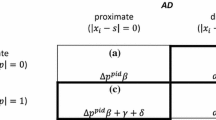Abstract
Much of the rational choice literature suggests that constituency considerations will dominate decision-making when constituency concerns are pronounced and the issue is conducive to citizen audit. The 1990 House of Representatives vote on a constitutional amendment banning flag burning provides a good test of this argument. Drawing from a survey of legislators and polling data we argue that even in the face of salient constituency views legislators demonstrated a willingness to vote their policy views and cross their constituents. We explore how concerns about reputation and other considerations contributed to this phenomenon. We also suggest directions for future research.
Similar content being viewed by others
References
Arnold, R.D. (1990).The logic of congressional action. New Haven: Yale University Press.
Bernstein, R.A. (1989).Elections, representation, and congressional voting behavior: The myth of constituency control. Englewood Cliffs, NJ: Prentice Hall.
Birnbaum, J.H. and Murray, A.S. (1987).Showdown at Gucci gulch. New York: Random House.
Biskupic, J. (1990a). Congress snaps to attention over new flag proposal.Congressional Quarterly Weekly Report: 1877, 1880–1881.
Biskupic, J. (1990b). For critics of flag measure, advance work pays off.Congressional Quarterly Weekly Report: 1962–1964.
Chressanthis, G.A., Gilbert, K.S. and Grimes, P.W. (1991). Ideology, constituent interests and senatorial voting: the case of abortion.Social Science Quarterly 72: 589–600.
Cohen, R.E. (1990). Flag debate enhances Foley's stature.National Journal 22: 1618.
Davidson, R.H. (1969).The role of the congressman. New York: Pegasus.
Derthick, M. and Quirk, P. (1985).The politics of deregulation. New York: Basic Books.
Donovan, B. (1990). Democrats struggle against GOP gibes over who hails the flag more proudly.Congressional Quarterly Weekly Report: 1879–1880.
Fenno, R.F. (1973).Congressmen in committees. Boston: Little, Brown and Company.
Fenno, R.F. (1978).Home style: House Members in their districts. Boston: Little, Brown.
Fiorina, M.P. (1974).Representatives, roll calls, and constituencies. Lexington, KY: D.C. Heath.
Fiorina, M.P. (1977).Congress: Keystone of the Washington establishment. New Haven: Yale University Press.
Gallup, G. (1991).The Gallup Poll: Public opinion 1990. Wilmington: Scholarly Resources.
Hird, J.A. (1991). The political economy of pork: Project selection at the U.S. Army Corps of Engineers.American Political Science Review 85: 429–456.
Jackson, J.E. and Kingdon, J.W. (1992). Ideology, interest group scores and legislative votes.American Journal of Political Science. Forthcoming.
Kalt, J.P. and Zupan, M.A. (1990). The apparent ideological behavior of legislators: testing for principal-agent slack in political institutions.Journal of Law & Economics 33: 103–131.
Kelman, S. (1987).Making public policy: a hopeful view of American government. New York: Basic Books.
Kingdon, J.W. (1989).Congressmen's voting decisions, 3rd. ed. Ann Arbor: The University of Michigan Press.
Krasno, J.S. and Green, D.P. (1988). Preempting quality challengers in House elections.Journal of Politics 50: 920–936.
Kuklinski, J.H. and McCrone, D.J. (1980). Policy salience and the causal structure of representation.American Politics Quarterly 8: 139–164.
Mansbridge, J. (1990). Self-interest in political life.Political Theory 18: 132–153.
Mayhew, D.R. (1974).Congress: The electoral connection. New Haven: Yale University Press.
McClosky, H. and Brill, A. (1983).Dimensions of tolerance: What Americans believe about civil liberties. New York: Russell Sage Foundation.
McCrone, D.J. and Kuklinski, J.H. (1979). The delegate theory of representation.American Journal of Political Science 23: 278–300.
Muir, W.K. (1982).Legislature: California's school for politics. Chicago: University of Chicago Press.
Peltzman, S. (1984). Constituency interest and congressional voting.Journal of Law & Economics 27: 181–210.
Pitkin, H.F. (1967).The concept of representation. Berkeley: University of California Press.
Poole, K.T. (1988). Recent developments in analytical models of voting in the U.S. Congress.Legislative Studies Quarterly 13: 117–133.
Vandoren, P.M. (1990). Can we learn the causes of congressional decisions from roll call data?Legislative Studies Quarterly 15: 311–340.
Author information
Authors and Affiliations
Additional information
For financial assistance in conducting this research, we wish to express appreciation to the Japanese Corporate Associates and the Committee on Electoral Politics, both of which are at the John F. Kennedy School of Government, Harvard University. We also wish to thank Joseph Kalt and John Kingdon for helpful comments on an earlier draft of this manuscript.
Rights and permissions
About this article
Cite this article
Lascher, E.L., Kelman, S. & Kane, T.J. Policy views, constituency pressure, and congressional action on flag burning. Public Choice 76, 79–102 (1993). https://doi.org/10.1007/BF01049344
Accepted:
Issue Date:
DOI: https://doi.org/10.1007/BF01049344




